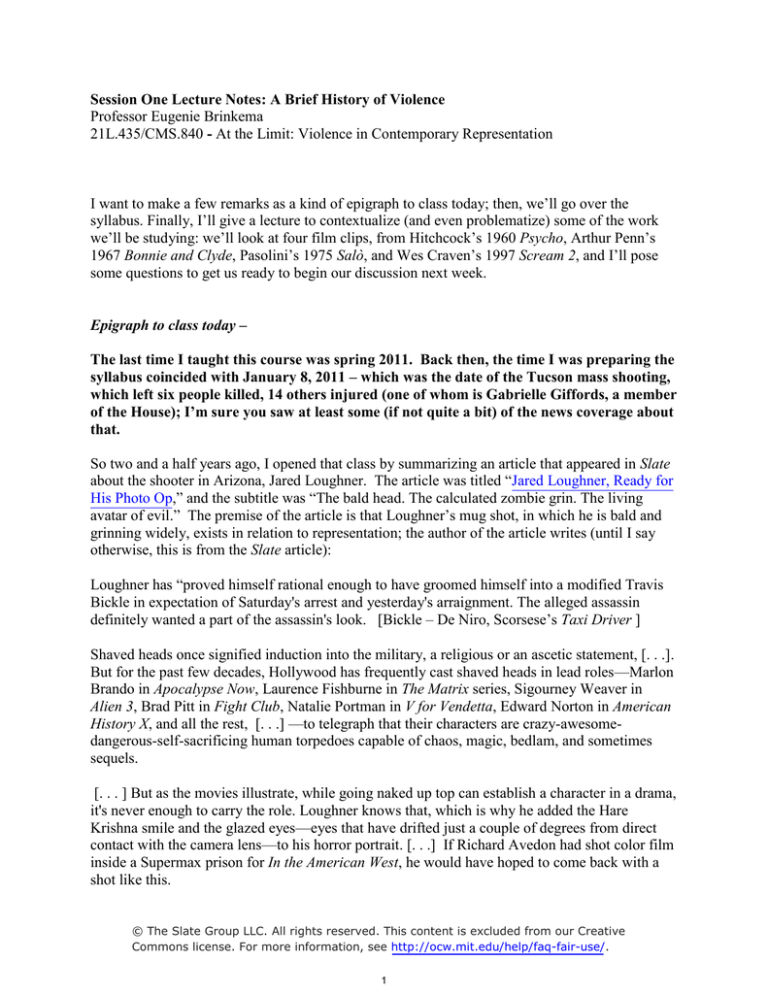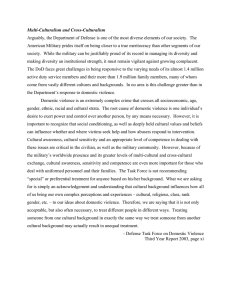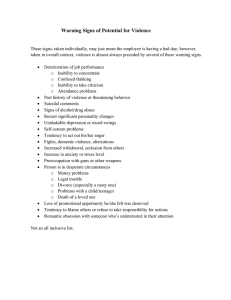
Session One Lecture Notes: A Brief History of Violence
Professor Eugenie Brinkema
21L.435/CMS.840 - At the Limit: Violence in Contemporary Representation
I want to make a few remarks as a kind of epigraph to class today; then, we’ll go over the
syllabus. Finally, I’ll give a lecture to contextualize (and even problematize) some of the work
we’ll be studying: we’ll look at four film clips, from Hitchcock’s 1960 Psycho, Arthur Penn’s
1967 Bonnie and Clyde, Pasolini’s 1975 Salò, and Wes Craven’s 1997 Scream 2, and I’ll pose
some questions to get us ready to begin our discussion next week.
Epigraph to class today –
The last time I taught this course was spring 2011. Back then, the time I was preparing the
syllabus coincided with January 8, 2011 – which was the date of the Tucson mass shooting,
which left six people killed, 14 others injured (one of whom is Gabrielle Giffords, a member
of the House); I’m sure you saw at least some (if not quite a bit) of the news coverage about
that.
So two and a half years ago, I opened that class by summarizing an article that appeared in Slate
about the shooter in Arizona, Jared Loughner. The article was titled “Jared Loughner, Ready for
His Photo Op,” and the subtitle was “The bald head. The calculated zombie grin. The living
avatar of evil.” The premise of the article is that Loughner’s mug shot, in which he is bald and
grinning widely, exists in relation to representation; the author of the article writes (until I say
otherwise, this is from the Slate article):
Loughner has “proved himself rational enough to have groomed himself into a modified Travis
Bickle in expectation of Saturday's arrest and yesterday's arraignment. The alleged assassin
definitely wanted a part of the assassin's look. [Bickle – De Niro, Scorsese’s Taxi Driver ]
Shaved heads once signified induction into the military, a religious or an ascetic statement, [. . .].
But for the past few decades, Hollywood has frequently cast shaved heads in lead roles—Marlon
Brando in Apocalypse Now, Laurence Fishburne in The Matrix series, Sigourney Weaver in
Alien 3, Brad Pitt in Fight Club, Natalie Portman in V for Vendetta, Edward Norton in American
History X, and all the rest, [. . .] —to telegraph that their characters are crazy-awesomedangerous-self-sacrificing human torpedoes capable of chaos, magic, bedlam, and sometimes
sequels.
[. . . ] But as the movies illustrate, while going naked up top can establish a character in a drama,
it's never enough to carry the role. Loughner knows that, which is why he added the Hare
Krishna smile and the glazed eyes—eyes that have drifted just a couple of degrees from direct
contact with the camera lens—to his horror portrait. [. . .] If Richard Avedon had shot color film
inside a Supermax prison for In the American West, he would have hoped to come back with a
shot like this.
© The Slate Group LLC. All rights reserved. This content is excluded from our Creative
Commons license. For more information, see http://ocw.mit.edu/help/faq-fair-use/.
1
The shaved character in the movies is almost never happy. Nobody tapping the primal forces he's
tapping could ever be happy. But being angry is too clichéd to be accepted. Hence Loughner's
bent smile, which recycles Jack Nicholson's psycho grin from The Shining and any number of
Bruce Dern and Jack Palance grimaces. [. . .]
Loughner has consciously sculpted himself into a modern computer-game avatar in his photo. By
this evening we'll have seen the shot so many times that its silhouette will be etched into our
brains, and a glance of it will be enough to remind us of where we were when we first heard
about the Giffords shooting, what we felt, and how we reacted to the debates about politics,
violence, and media that immediately followed. It ranks with the mug shots of Charles Manson,
Lee Harvey Oswald, James Earl Ray, and Timothy McVeigh. Somewhere, musicians are
appropriating his name for their punk band, others are printing T-shirts, somebody is writing an
instant-book about him, & somebody has made it their Twitter icon.”
EB again: the reason I wanted to open with this as an epigraph to our class is that the Slate article
figures Loughner’s photograph in a long history of representation: what we know of Loughner is
reduced to a visual analogue (mug shot) and the semiotics (meaning: the meaning) of that mug
shot are placed in a history of films, photographs, and the recycling of those tropes in new media.
I’m going to gloss this a bit, because we’ll be talking quite a bit about postmodern representation
in this class, but one longstanding trope in critical accounts of our historical era (late capitalism,
postmodern, accelerated globalization) is that representation and the real have blurred with each
other: such that, news footage from 9/11 of people who were in Manhattan and saw plumes of
smoke live, “It looked like something from a movie.” Loughner, goes the argument in this
article, is legible as a signifier because his image participates in a history of images of mass
murderers from visual culture. This structure – whereby a real figure models himself after
figures from popular culture (life imitating art imitating life) is a trope that’s quite common with
serial killers; we’ll be talking more about this intimate relationship between violence and the
media, even as it is negotiated within media texts. (And in a case like Taxi Driver, it’s not just
the claim that Loughner’s image is re-presented as something familiar from that iconography, but
that film, which is about Travis Bickle’s vigilante fantasies itself became part of the obsessional
fantasies of John Hinckley who shot Roland Reagan claiming he wanted to impress Jodie Foster,
the actress who plays a prostitute in the film, and whom Travis Bickle wants to save – to the
point that the film was played during the trial.)
Now, this is a class on contemporary representation: representation is a presentation to the mind
of an idea or an image; it’s a rendering of something else, it symbolizes or stands in for
something else (why representation can have a political and an aesthetic meaning). This is not a
course in “real” violence as such, as might be studied in a political science or an anthropology or
sociology class. This is not a class in sociological analysis of media effects—we’re not going to
be talking about research on whether violent films cause copycat crimes; there is no “data” in
this class. This is a class in interpretation.
So, there’s a sleight of hand to open class today by talking about a real instance of mass violence,
one that left real material bodies wounded and dead. But it’s not as though the two are totally
unrelated or different beasts; the two reals are constantly mutually affecting each other and the
way in which we understand the “real” and the “represented” requires recourse to the other mode
© The Slate Group LLC. All rights reserved. This content is excluded from our Creative
Commons license. For more information, see http://ocw.mit.edu/help/faq-fair-use/.
2
of discourse. We’re going to explore this relationship between representation and the real more
fully, and we’ll critique it, interrogate it, but I wanted to open by suggesting that any firm divide
that suggests that we’re “only” studying representation—or that violent representation is an
entirely separate thing from thinking about “real” violence—is a difficult division to hold fast
and firm.
When we talk about contemporary literature and film that pose violence as a problem; that
deploy it as an aesthetic; that attempt to think about it in relation to ethics and politics and
history; that use formal devices that collude with (or critique) violence, and that in essence
interrogate violence (even as some of our works will be accused of reveling or even irresponsibly
deploying) violence, we’ll be using a methodology firmly rooted in the humanities: textual
analysis, contextual analysis, close reading, speculative thought, and critical theory. This doesn’t
mean, however, that we’re not continually getting at ethical and political consequences. It’s just
that our analyses of representation will get us there.
So, that’s how I opened class last time. Loughner’s photograph was a useful example –
posing issues of the intertwined relationship of representations of violence and real violence; the
ways real violence can style themselves after representation, and the way representation can
itself be blamed as causing ‘real’ violence. And two and a half years isn’t exactly ancient
history. So it could hold for today as well.
BUT – one of the interesting, troubling and inevitable facts about working on violence and
representation is that it is a renewable, deep field of material. So let’s a get more recent
and come a bit closer to home.
You have perhaps seen this – or, maybe only read about it…Hand out Rolling Stone.
This is the (now infamous) Rolling Stone issue from this summer -- about three months
after the Boston Marathon bombings (the ones as well you know that also left an MIT
police officer dead and many people injured) – with the cover image of Dzhokhar Tsarnaev,
the younger brother of the two marathon bombers. As you may well also know (though if you
weren’t in Boston this summer, maybe you missed it), the cover was so controversial that
Walgreens and CVS (nationally) and lots of local stores refused to carry and sell the issue.
The mayor of Boston came out and publically accused the magazine of offering Tsarnaev
“celebrity treatment.” And of course the normal course of figuring on the cover of rolling stone
is not just “for” celebrities, but is itself part and parcel of making and denoting certain people
and figures as celebrities (it’s not a neutral tool of documentation, but colludes in deeming
certain figures as being worthy of having fame, status, name and image recognition conferred
upon them).
FOR EXAMPLE: PLAY Dr. Hook SONG – 1973. Cultural capital.
Then there’s the issue of visual form. Look at the image – the tussled hair; the direct gaze at the
camera. Like the semiotic chain with Loughner (which runs through Apocalypse Now to Taxi
Driver) – this one seems to echo the way in which the magazine has framed romantic, Byronic
3
figures like Jim Morrison – does it make him too handsome? Too desirable? Why is that a
problem – what anxiety is provoked over the prospect of the mix of a sexualized image with a
narrative of violence…. Compare the two covers; this, and the one long after Morrison’s dead…
But it’s even more complicated, because this debate itself is one we’ve had before: when the
magazine did a special issue on Charles Manson in 1970, interviewing him from prison where
was himself already a celebrity who had a very vexed relationship with popular media, critiquing
its excesses and yet using it to disseminate his own self-mythologizing narrative, it was criticized
for framing him in a Christ-like pose and light – which again, becomes an issue of interpretation:
to Manson's followers, he was a messianic figure, so is the visual representation colluding with
that discourse (i.e. supporting it, participating in it) or is it critiquing it? It’s complicated. But
then again, the image is also reminiscent of the Rolling Stone cover of billionaire Paul Getty’s
grandson, who was kidnapped, held for ransom and had his ear cut off before his return – so the
image on its own is also a visual echo of a young boy synonymous with victimization,
vulnerability, exploitation. (In another twist back to representation, the severed ear and
kidnapping/extortion scheme, and Paul Getty’s refusal to provide the ransom, is itself echoed in
part of the plot for the Coen Brothers’ film The Big Lebowski. So, again, the path goes both ways
– the real and the representational always mutually affecting each other.)
If one wants to trace the mediatization of this issue (which is a debate in the media about the
relation of the media to covering violence), it’s worth noting that the copies that were for sale
flew off newsstands and the resulting effect of making the issue scarce produced a kind of
“limited edition” dimension to it, as though it were a rare bootleg of some underground album (I
bought mine weeks later for a very high premium off a collector on ebay – one who sells rare
issues of magazines but also, for example, serial killer trading cards, another bonding of
violence, representation, media celebrity and commodification that we’ll talk about as often if
not always present in the case of the figure of the serial killer). Much criticism of the cover was
that it participated in the “branding” of the bombings – providing as the visual iconography that
is a shorthand for the events not a victim or a rescuer but the perpetrator of violence; poses the
question of who has profited from it?
But it’s still more complicated: The image has a caption – and as often happens in the relation
between word and image, in which the latter is polysemous (= many-meanings), the caption
grounds those meanings, fixes and shapes them into something concrete. The caption reads “The
Bomber: How a Popular, Promising Student was Failed by His Family, Fell into Radical Islam,
and Became a Monster.”
The subtitle is not descriptive or labeling (name, birthdate); rather, this subtitle tells a story: and
it goes like this – We start with a state of normalcy (Normal = unviolent; popular; promising –
the American Dream); then something privately goes wrong – he’s failed by his family
(privatizing story: it’s about family, not economics or politics or ideology); and then became a
monster (something not-normal; because only monsters perpetrate violence). For all that the
image seems to suggest celebrity, normalcy, sexual desire, allure, the caption promises causal
explanations, the breakdown of normalcy, the pathological family as blameworthy, and the final
judgment of monstrosity.
4
We’ll see this kind of formula again and again this semester – as early as next week, when we
look at the relation of violence to the imaginary of “America” and then the following week when
we start the novel American Psycho, we’ll continually encounter this question: Is violence
something monstrous, abnormal, unusual, exceptional, different… or is violence, in fact,
precisely something utterly, completely expected, ordinary, banal – Is it the very essence of the
normal and normative? Is violence bound up with the failure of the family, or a commitment to
the ideology of protecting and shoring up the family? Is violence something that the monstrous
do, or is violence precisely the logical outcome of the most ordinary and normal course of events
(in the Ellis novel, is it the logical consequence of capitalism run amuck – in a world where you
can buy and use and exploit anything, are human bodies an obvious commodity to be added to
the list?)
The interesting thing about the debate about Rolling Stone is that it tends to oscillate
between opposing camps: One suggests the cover glorifies him, promotes him to the level of
the celebrity. The other that it normalizes him, brings him down to earth instead of
figuring him as a monster. The status of this debate about violence (abnormal or normal) and
the question of what images should do (expose the normal or highlight the abnormal; do they
collude with the unethical dimensions of violence; do they need to accuse or confront us with the
graphic? What should we ask of images – what should we ask of representations of violence?
Why is there such a persistent desire for The Face of Evil – what’s at stake in wanting ethical
abnormality to be visually legible?) If the image of Tsarnaev is too pretty, too easy (in a
manner) to look at, what’s the alternative: the image (circulated in other periodicals) of him
bloodied, shot by the police? Would that image have its own problems: would it be open to
critiques that it was reminiscent of images of soldiers or martyrs; would it be accused of
voyeurism, allowing consumers of the magazine to imagine themselves into the position of the
violent event without risking anything? If the problem with the photograph is that it’s too
consumable, then what about an image difficult to look at, hard to take in, something bloody,
something graphic, even disgusting – something that makes us sick upon looking at it? Is the
opened, mutilated body a better option (what does ‘better’ mean?) What about a black cover? A
refusal to represent the bombings at all? Is it more responsible to commit to the ultra-violent,
representationally? This debate – between critique and voyeurism – about whether
representation is “reflective or affective” (makes us think or makes us feel) is a vibrant one. I’d
encourage you to keep an open mind about these terms: to ask whether critique can only come
from taking a “reflective” stance, or whether aestheticizing, even trivializing, prettifying violence
might be one way into a critique.
These are just some of the questions we’ll ask about this semester. But from the outset, I
hope it’s clear that these issues of interpretation are multi-layered and complex. Violence,
intertwined with representation, has a way of slipping away from final judgments – of
posing contradictions that are difficult, if not impossible, to resolved.
5
MIT OpenCourseWare
http://ocw.mit.edu
CMS.840 / 21L.435 At the Limit: Violence in Contemporary Representation
Fall 2013
For information about citing these materials or our Terms of Use, visit: http://ocw.mit.edu/terms.




